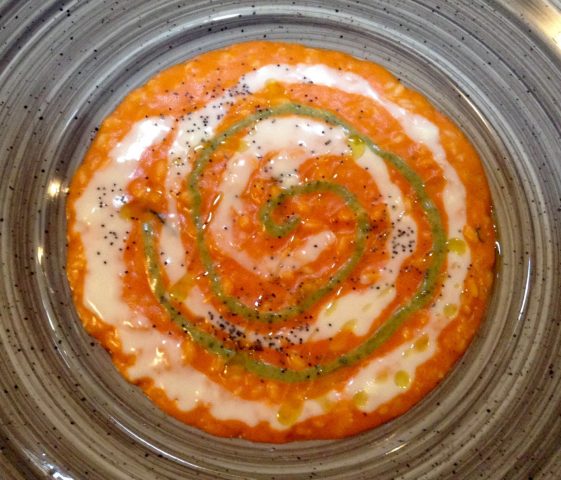Eat it again, Sam (2)
Aside from being a cuisine of negation, Jewish-Yiddish food is at the same time a festive cuisine and there is a traditional dish for every religious holiday on the calendar. At Purim one eats Oznei Haman (stuffed pastry pockets with dried fruit) to re-enact the challenge to the ‘bad guy’ in the Biblical story of Ester. Latkes, potato crepes cooked in chicken fat, are eaten to celebrate the miracle of the oil during Hanukkah. At the seder during Passover, when it is forbidden to use yeast to remember the exodus from Egypt, fanciful food is prepared using unleavened bread and various herbs like horseradish and parsley and haroseth. A dish of apples and honey, is also made.
Non-religious holidays are celebrated out of the home eating particularly elaborated foods, those that are usually never made at home. One of these is lox, a smoked salmon that is slightly more tasty and fatty than the traditional one from Scotland. It is unheard of in New York to have a Sunday brunch without two fundamentals items: Nova Scotia Lox on a bagel spread with cream cheese and a copy of the Sunday New York Times that weighs a ton. Also popular away from home are cold cuts often made with beef brisket which is particularly fatty and flavorful. When made with brine it becomes aromatic corn beef, while when it is cured with salt and a lots of pepper it becomes pastrami, perhaps the best cold cut being rich and spicy. These meats are consumed hot on rye bready spread with mustard and served with a lot of pickles.
Real home cooking is a different story and involves long hours of preparation to give flavor and soften the poor prime ingredients, which have already been passed over by the well-to-do. One of the basic meals is boiled meats and when chicken is boiled the broth is cooked with vegetables and garlic to make a rich and fragrant soup. Chicken soup is considered to be a cure-all and in America is even referred to as ‘Jewish penicillin’ and every Jewish mother believes it is a miracle cure.
Another basic food is a mixture of chicken fat and/or eggs with various starches: bread crumbs, unleavened flour, barley or buckwheat. This mixture is used to make various types of dumplings which are cooked in broth. The most known are the kneidlach (matzo ball and knodel of unleavened bread) and the kreplach, a type of tortellini. An alternative is gefilte fish, a fish ball of white fish and carp that is served cold in aspic. In order to enhance its flavor exaggerated amounts of horseradish and beets are added.
The third pillar of traditional Jewish home cooking are sautéed – actually burned – onions fried in chicken fat which serves as a base for all meat stews together with celery, carrots and tomatoes. Using beef brisket one makes the classic, overcooked dish of honor for shabbat.
The last basic food is the sweet and sour preparation that has the natural sweetness of vegetables like cabbage, onions and carrots, the apotheosis of which is tzimmes, a side dish of carrots, sweet potatoes and raisons. During a big, traditional family meal it is served with overcooked beef and some potatoes crepes fried in chicken fat. It not by chance that the expression “make a big tzimmes’ means to exaggerate.
Looking at all these dishes one wonders why the Jews were not killed by their own Yiddish cuisine before being persecuted by their enemies. The answer is that the traditional diet and the wellness of a people create a kind of ecosystem. In the case of the Jews – and every Italian can understand this – food more than individuals is what keeps a community united and its historic memory alive.
*History of Art Professor at Princeton University

 Italiano
Italiano







